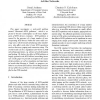Free Online Productivity Tools
i2Speak
i2Symbol
i2OCR
iTex2Img
iWeb2Print
iWeb2Shot
i2Type
iPdf2Split
iPdf2Merge
i2Bopomofo
i2Arabic
i2Style
i2Image
i2PDF
iLatex2Rtf
Sci2ools
PERCOM
2005
ACM
2005
ACM
The Problem of Bluetooth Pollution and Accelerating Connectivity in Bluetooth Ad-Hoc Networks
This paper investigates a real-world problem termed "Bluetooth (BTH) pollution", which is expected to become commonplace as the mass deployment of BTH devices continues. BTH pollution is caused by the presence of a large number of noncooperating BTH devices within the same radio coverage area, which beyond introducing radio interference, also affect each other's basic BTH operations such as discovery, paging and connection setup. The overall result can be a significant slow-down in BTH networking operations, e.g. ad-hoc network formation and healing. We believe the effect of BTH pollution is largely ignored in the BTH ad-hoc networking literature. In this paper we provide an insight on the causes of this problem, as well as simulation and experimental results that illustrate it. Finally, we propose a solution to accelerate BTH ad-hoc networking based on the use of the Class of Device (CoD) information specified in the BTH standard.
| Added | 24 Dec 2009 |
| Updated | 24 Dec 2009 |
| Type | Conference |
| Year | 2005 |
| Where | PERCOM |
| Authors | Somil Asthana, Dimitris N. Kalofonos |
Comments (0)

